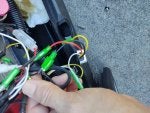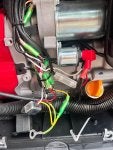A little over a year ago I bought a Predator 9500 inverter generator. I broke it for 30 hours and changed the oil. Since then I have run it once every 2-3 months for at least 30 min. The fuel has Sta-Bil added.
On Monday 09/12/22 the power was out early in the morning. The generator fired up but cut off after about 20 seconds. When it would shut down the red oil alarm light would come on. It did this 5-6 times before I gave up. The generator only had 33.8 hours on it. The oil level is correct and the unit is on level ground. I tried reaching out to HFT tech support on the phone with no answer. And I sent an email to product support with no answer.
I had read and seen on YouTube that if the low oil sensor is clogged or bad it will cause this issue. So on Tuesday afternoon I tried disconnecting the yellow wire at the sensor. It still started and ran for about 20 seconds before shutting down. The red oil alarm light would come on as before. I also noticed that the CO light flashed yellow. The generator was outside with more than ample clearances. After a few attempts I finally got it running and it ran for about 1.25 hours.
Well on Wednesday I tried starting it and now it will not even start. The low oil light comes on, but no lights at the CO indicator light.
Yesterday I finally received a call from HFT tech support. Based on what I described, he feels it is probably a bad CO sensor. They are sending me a new sensor. Hopefully this will solve the issue.
Regardless, I am considering bypassing both the CO and oil level sensors. Looking at the attached photos, does anyone see what wires should be disconnected/modified? Obviously doing so would be my responsibility/liability. I have not been able to find a detailed wiring diagram.
Any help would be greatly appreciated.
![]()
![]()
![]()
![]()
On Monday 09/12/22 the power was out early in the morning. The generator fired up but cut off after about 20 seconds. When it would shut down the red oil alarm light would come on. It did this 5-6 times before I gave up. The generator only had 33.8 hours on it. The oil level is correct and the unit is on level ground. I tried reaching out to HFT tech support on the phone with no answer. And I sent an email to product support with no answer.
I had read and seen on YouTube that if the low oil sensor is clogged or bad it will cause this issue. So on Tuesday afternoon I tried disconnecting the yellow wire at the sensor. It still started and ran for about 20 seconds before shutting down. The red oil alarm light would come on as before. I also noticed that the CO light flashed yellow. The generator was outside with more than ample clearances. After a few attempts I finally got it running and it ran for about 1.25 hours.
Well on Wednesday I tried starting it and now it will not even start. The low oil light comes on, but no lights at the CO indicator light.
Yesterday I finally received a call from HFT tech support. Based on what I described, he feels it is probably a bad CO sensor. They are sending me a new sensor. Hopefully this will solve the issue.
Regardless, I am considering bypassing both the CO and oil level sensors. Looking at the attached photos, does anyone see what wires should be disconnected/modified? Obviously doing so would be my responsibility/liability. I have not been able to find a detailed wiring diagram.
Any help would be greatly appreciated.









